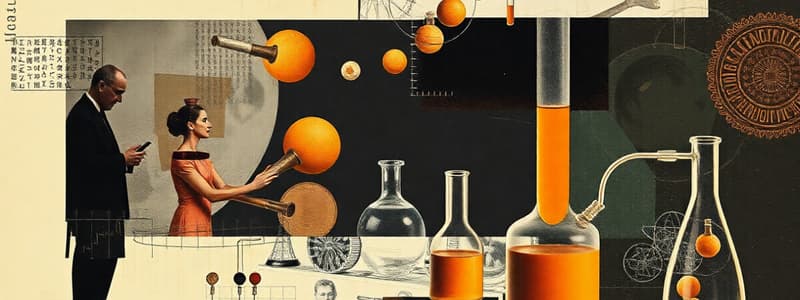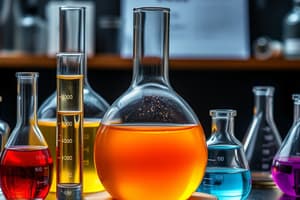Podcast
Questions and Answers
What is the primary purpose of classifying items in scientific investigations?
What is the primary purpose of classifying items in scientific investigations?
- To create linear relationships between variables.
- To organize and identify large numbers of living things. (correct)
- To eliminate the need for controlled variables.
- To summarize findings from experiments.
Which relationship described in a graph indicates that one variable does not affect another?
Which relationship described in a graph indicates that one variable does not affect another?
- Inverse relationship
- Linear relationship
- No relationship (correct)
- Negative linear relationship
What does 'pattern seeking' involve in the context of scientific investigations?
What does 'pattern seeking' involve in the context of scientific investigations?
- Analyzing small datasets for trends.
- Using a large dataset to determine relationships between variables. (correct)
- Grouping items based on color and size.
- Identifying characteristics of unknown items.
Which of the following steps is NOT part of the five basic steps of a scientific investigation?
Which of the following steps is NOT part of the five basic steps of a scientific investigation?
In a scientific investigation, what is meant by controlled variables?
In a scientific investigation, what is meant by controlled variables?
What is the purpose of proposing a hypothesis in a scientific investigation?
What is the purpose of proposing a hypothesis in a scientific investigation?
In the steps of a scientific investigation, what comes after making observations?
In the steps of a scientific investigation, what comes after making observations?
Which of the following best exemplifies a question that a scientist might ask after making an observation?
Which of the following best exemplifies a question that a scientist might ask after making an observation?
During which step of a scientific investigation does a scientist typically refine their hypothesis?
During which step of a scientific investigation does a scientist typically refine their hypothesis?
Which of the following is NOT one of the five basic steps of a scientific investigation?
Which of the following is NOT one of the five basic steps of a scientific investigation?
Which of the following best defines a controlled variable in an experiment?
Which of the following best defines a controlled variable in an experiment?
Flashcards
Fair Test
Fair Test
An experiment where only one factor is changed at a time to ensure a reliable result.
Classifying
Classifying
Organizing things into groups based on common features.
Independent Variable
Independent Variable
The factor that is changed or manipulated in an experiment.
Dependent Variable
Dependent Variable
Signup and view all the flashcards
Controlled Variable
Controlled Variable
Signup and view all the flashcards
Scientific Observation
Scientific Observation
Signup and view all the flashcards
Hypothesis
Hypothesis
Signup and view all the flashcards
Drawing a Conclusion
Drawing a Conclusion
Signup and view all the flashcards
Pattern Seeking
Pattern Seeking
Signup and view all the flashcards
Linear Relationship
Linear Relationship
Signup and view all the flashcards
Negative Linear Relationship
Negative Linear Relationship
Signup and view all the flashcards
What variable should I change?
What variable should I change?
Signup and view all the flashcards
What variable should I measure?
What variable should I measure?
Signup and view all the flashcards
What variables should I keep the same?
What variables should I keep the same?
Signup and view all the flashcards
Types of Scientific Investigations
Types of Scientific Investigations
Signup and view all the flashcards
Study Notes
Practice of Science
- Scientific investigations involve steps to understand unknown phenomena.
- These steps typically consist of making observations, asking questions, proposing hypotheses, conducting experiments, and drawing conclusions.
- If results do not support a hypothesis, scientists may revise and test again.
- Examples provided include dry cell lifespans and the discovery of penicillin.
The Discovery of Penicillin
- Alexander Fleming observed mold on a bacterial dish and noted a region without bacteria.
- He questioned why no bacteria grew around the mold.
- He proposed a hypothesis: the mold produces a substance that kills bacteria.
- He performed experiments to test this hypothesis.
- The results supported his hypothesis, and he drew a conclusion that the mold produces a substance that kills bacteria.
Basic Steps of Scientific Investigations
- Making Observations: Scientists carefully examine the world around them.
- Asking a Question: What is the observed phenomenon?
- Proposing a Hypothesis: An educated guess about the observation and how to resolve the question
- Doing Experiments: Experiments test the hypothesis.
- Drawing a Conclusion: Determine whether the results validate the hypothesis. Modify or adjust the hypothesis if necessary or if results do not support it.
A Closer Look at Scientific Investigations
- Scientists use everyday life examples and observations to investigate.
- Observations use senses such as sight, smell, touch, and hearing.
- An example shows a child observing that people move faster on a steeper portion of a slide, prompting a scientific question.
Proposing a Hypothesis
- A hypothesis is not a guess; it is based on observations and information gathered during research.
- Amy proposed a hypothesis about the time it takes for an object to reach the ground on a slide.
- Examples include testing the time for an object to reach the ground on different sloping slides or different materials on a slide.
Carrying out Experiments
- Experiments test hypotheses.
- A fair test ensures only one variable is being changed at a time, whilst all other factors remain the same.
- Examples focus on creating a fair experiment involving slides and comparing different materials
Fair Tests
- A fair test involves changing only one variable at a time.
- Variables that are kept the same are called controlled variables.
- The variable being changed is the independent variable.
- The result of the experiment is the dependent variable.
Types of Scientific Investigations
- Fair Testing: Testing hypotheses using a controlled experiment to see if the hypothesis is valid or invalid
- Pattern Seeking: Gathering data, creating graphs and drawings to identify trends or relationships
- Classifying: Grouping objects, living things or ideas based on shared characteristics
Identifying Variables
- Independent Variable: The variable you change. In the example, this was the slope/height of the slide
- Dependent Variable: The variable you measure. In the example, this may be the time it takes for the object to reach the ground.
- Controlled Variables: Variables that stay the same throughout the experiment. In the example, these could be the size, mass, and shape of the ball being used to test the slope of the slide.
Studying That Suits You
Use AI to generate personalized quizzes and flashcards to suit your learning preferences.




